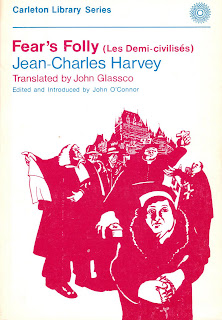
Les Demi-civilisés
Jean-Charles Harvey
Montreal: Éditions du Totem, 1934
Seventy-five years ago today Jean-Marie-Rodrigue Villeneuve, Archbishop of Quebec, had Les Demi-civilisés placed on the Index of Prohibited Books, thus ensuring that there will always be those who make a special effort to track it down. Not always an easy thing to do. While Cardinal Villeneuve's condemnation most assuredly helped spur sales – the 3000 copy print run sold out in a matter of weeks – it also meant that the novel, Harvey's second, remained out of print until 1962, when a revised edition was published.
In his 'CONDEMNATION DU ROMAN "LES-DEMI-CIVILISES"', the Cardinal cites article 1399, 3°, of the Code of Canon Law, which calls for the banning of works that 'purposely attack religion or good morals'. In fact, both are left unscathed; the reader finishes the novel with virtue intact. Harvey doesn't attack religion, but the Church. His demi-civilisés are not the uneducated, but their repressors: an alliance of clergy, politicians and businessmen.

The Globe and Mail, 30 April 1938
A pariah to some, a hero to others, Harvey did maintain a certain profile, and was sought out as a speaker. Pierre Chalout of Le Droit called him the 'grand-père de la révolution tranquille', yet during the final years of his life Harvey fell out of favour with a thud. His promotion of bilingualism and defence of federalism, as articulated in Pourquoi je suis anti-séparatiste (1962), alienated a great many Quebec intellectuals. Thirty-two years after his death, Quebec City has no rue Harvey, nor does Montreal. All but one of his books is out of print.

Les Demi-civilisés is one of a very small number of Canadian novels to have received two English language translations. The first, by Lukin Barette, is saddled with the rather unfortunate title Sackcloth for Banner (Toronto: Macmillan, 1938). As if that weren't bad enough, it may well be the worst translation yet made of a Canadian novel. Barette omits passages, changes names, invents dialogue and commits what amounts to a rewrite of the final two chapters. All is set right with Fear's Folly, John Glassco's 1980 translation, published two years later by Carleton University Press.
Object and Access: Sadly, predictably, all but absent from our public libraries. A decent copy of the first edition is currently listed online at US$30.00. An incredible bargain. English-language editions aren't dear. As Sackcloth for Banner, it goes for between C$60 and C$135. Fear's Folly is usually on offer for about C$15.



















